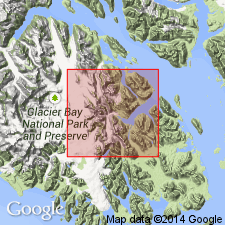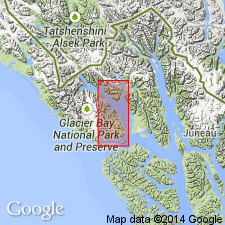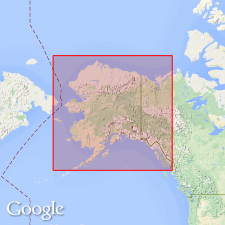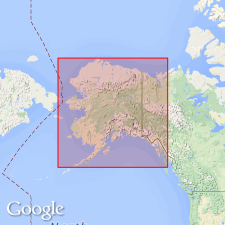
- Usage in publication:
-
- Willoughby limestone*
- Modifications:
-
- First used
- Biostratigraphic dating
- Dominant lithology:
-
- Limestone
- AAPG geologic province:
-
- Alaska Southeastern region
Summary:
Willoughby limestone occurs northwest side of entrance to Geikie Inlet, Marble Mountain, and Francis, Drake, and Willoughby Islands. Thickness varies but 5000 ft or more on Marble Mountain. Mainly fine- to medium-grained crystalline limestone; in places coarsely crystalline marble; usually massive. Age is Late Silurian based on fossils. Fossils collected by H.P. Cushing (1890) and identified by Charles Schuchert; diagnostic LEPERDITIA (ostracode). Other, later fossil collections made from same locality also Late Silurian -includes LIMOPTERA sp., PARACYCLAS sp., PLEUROTOMARIA sp., MURCHISONIA sp., MEGALOMUS sp. (Wright, F.E. and C.W., 1937); BATHMOPTERUS LIRATUS and PYCINODESMA GIGANTEUM (Kirk, 1928); HORMOTOMA sp., COELOCOULAS sp., HOLOPEA sp., ECCYLIOMPHALUS sp., and abundant PYCINODESMA GIGANTEUM (Kirk from collection of Rossman, 1949).
Source: GNU records (USGS DDS-6; Menlo GNULEX).

- Usage in publication:
-
- Willoughby Limestone*
- Modifications:
-
- Named
- Biostratigraphic dating
- Dominant lithology:
-
- Limestone
- AAPG geologic province:
-
- Alaska Southeastern region
Summary:
Named for exposures on Willoughby Island which has the best and most typical section. Southernmost exposure on Lemesurier Island; crops out as narrow band northwestward from north shore of Iay Strait opposite Lemesurier Island and connects to large flat-lying outcrop on White Cap Mountain. North of White Cap Mountain, intensely deformed and crops out in small isolated structurally complex units. Also occurs underlying central part of Glacier Bay and as far north as Tidal Inlet. Not the limestone south of Sandy cove (southeast corner D-1 quad) as stated by Cushing (1892). Massive blue-gray to white limestone; lacks internal structures. Top and bottom contacts unknown. Thickest known section 3366 ft in Marble Mountains; could be up to 5000 ft thick. Contains fossils (best localities on northeastern shores of Drake and Willoughby Islands). Kirk (1927) considers fossils to be Late Silurian in age.
Source: GNU records (USGS DDS-6; Menlo GNULEX).

- Usage in publication:
-
- Willoughby Limestone*
- Modifications:
-
- Age modified
- AAPG geologic province:
-
- Alaska Southeastern region
Summary:
Age of Willoughby Limestone changed from Late Silurian to Middle Devonian based on occurrence of PYCNODESMA. PYCNODESMA was originally considered to be Late Silurian (Kirk, 1927), but later regarded as Devonian in age; Kennel Creek Limestone that contains PYCNODESMA has been assigned to the Middle Devonian (Loney, Condon, and Dutro, 1963). Therefore other PYCNODESMA-bearing limestones, including the Willoughby, are also assigned to the Middle Devonian.
Source: GNU records (USGS DDS-6; Menlo GNULEX).

- Usage in publication:
-
- Willoughby Limestone*
- Modifications:
-
- Age modified
- AAPG geologic province:
-
- Alaska Southeastern region
Summary:
Age of Willoughby Limestone is shown to be Silurian in correlation chart of Glacier Bay-Chilkat Range. Is 5000+ ft thick. Underlies Tidal Formation (Silurian).
Source: GNU records (USGS DDS-6; Menlo GNULEX).
For more information, please contact Nancy Stamm, Geologic Names Committee Secretary.
Asterisk (*) indicates published by U.S. Geological Survey authors.
"No current usage" (†) implies that a name has been abandoned or has fallen into disuse. Former usage and, if known, replacement name given in parentheses ( ).
Slash (/) indicates name conflicts with nomenclatural guidelines (CSN, 1933; ACSN, 1961, 1970; NACSN, 1983, 2005, 2021). May be explained within brackets ([ ]).

